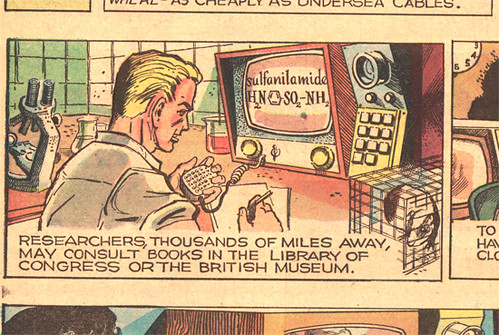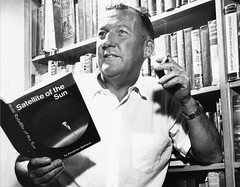
PREV ARTICLE
NEXT ARTICLE
FULL ISSUE
PREV FULL ISSUE
ATHELSTAN SPILHAUS: INVENTOR, ENGINEER, CARTOONISTRegarding the 1964 cartoon about coinage published last week, Kenneth Berger writes: From my days as an oceanographer, I thought the name "Athelstan Spilhaus" rang a bell, and it did. Prof. Spilhaus started NYU's Meteorology and Oceanography Dept. at the old University Heights campus in the Bronx (my alma mater). More importantly, however, he was the inventor of the bathythermograph. This was an instrument which allows for temperature measuring at various ocean depths. Its original purpose was to aid in the detection of German U-Boats during WWII. Although they have been replaced by more sophisticated instruments, they still make for interesting discussions and in some circles are considered a collectible. I myself have one. He was also the engineer-in-charge of the weather balloon that sparked the Roswell, N.M. incident about a crashed UFO.
It makes sense that a scientist would comment on the weight and purity of the metals in our coinage. "Athelstan Spilhaus" is such an unusual name I assumed like many of us that it was a pseudonym. But like they say, "you could look it up" and indeed Athelstan Spilhaus was not only a real person, but one of great influence in his day. Here's an excerpt from an article about him in Smithsonian Magazine.
-Editor
The comic strip that Kennedy was referring to was called “Our New Age” and ran in about 110 Sunday newspapers all around the world from 1958 until 1975. Much like Arthur Radebaugh‘s mid-century futurism comic “Closer Than We Think,” which ran from 1958 until 1963, “Our New Age” was a shining example of techno-utopian idealism. Not all of the strips were futuristic, but they all had that particular brand of optimism that so characterized postwar American thinking about science and technology. Each week the strip had a different theme, illustrating a scientific principle or advancement in an easily digestible way. Some of the strips tackled straightforward scientific topics like meteors and volcanoes, while others explained the latest scientific developments in synthetic fibers, space travel and lasers. The strip seemed to say that the building blocks of the future were laid out before us, we just had to build it. As Spilhaus tells it, he was inspired to start the comic strip in October of 1957 after the Soviets launched Sputnik — the first human-made satellite — into space. He was concerned that American kids weren’t showing enough interest in science and technology. “Rather than fight my own kids reading the funnies, which is a stupid thing to do, I decided to put something good into the comics, something that was more fun and that might give a little subliminal education,” he said. “Our New Age” had an enormous audience almost immediately. A 1959 article in Time magazine noted that the strip appeared in 102 U.S. and 19 foreign newspapers.

During the majority of the time that he was writing “Our New Age,” Dr. Spilhaus was the dean of the University of Minnesota’s Institute of Technology. While in Minnesota, Spilhaus became good friends with another under-appreciated futurist thinker, journalist Victor Cohn. People were constantly asking Spilhaus, a jet-set man who had his hand in everything, how he could be involved in so many seemingly disparate projects. He told his friend Victor, “…I don’t do ‘so many things.’ I do one. I think about the future.” The December, 1971 issue of Smithsonian magazine published a profile on Dr. Spilhaus and mentioned that some weren’t so pleased that a distinguished academic was writing Sunday comic strips. The articles notes that his writing “Our New Age” was, “thought by some an undignified avocation.” Dignified or not, there’s no question that influencing an American president, and reaching a worldwide audience with a message promoting science was no small feat. Spilhaus himself responded to the academics who questioned his supposedly undignified side project: “Which of you has a class of five million every Sunday morning?”
To read the complete article, see:
To read the earlier E-Sylum article, see:
The Numismatic Bibliomania Society is a non-profit organization promoting numismatic literature. See our web site at coinbooks.org. To submit items for publication in The E-Sylum, write to the Editor at this address: whomren@gmail.com To subscribe go to: https://my.binhost.com/lists/listinfo/esylum All Rights Reserved. NBS Home Page Contact the NBS webmaster 
|
